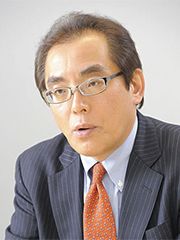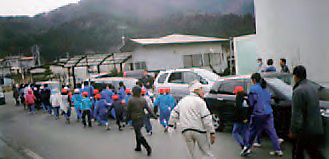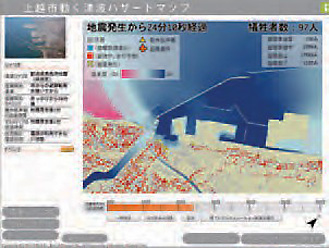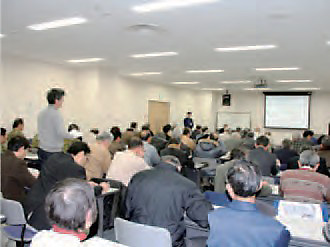Research Results
For achieving zero victims in a natural disaster
Dynamic hazard map and disaster prevention education FY2016

- Toshitaka Katada (Director of the Institute of Social Technology, I.D.A Co. Ltd./Professor at the Graduate School of Engineering, Gunma University)
- RISTEX Implementation-Support Program
- "Establishing a Foothold for Nationwide Expansion of Tsunami Education Using a Comprehensive Tsunami Disaster Scenario Simulator" Person responsible for implementation (2007-2011)
Educational activities for disaster prevention backed by scientific evidence behind a 'miracle'
A 'miracle in Kamaishi' —. In the Great East Japan Earthquake on March11 in 2011, a great number of lives were spared, which attracted the public's attention as a'miraculous 'event. In Kamaishi City in Iwate Prefecture, which was hit by a tsunami, 99.8% of about 3,000 elementary and junior high school students of 14 schools in the city survived. In particular, the students of Kamaishi-Higashi Junior High School were praised for their actions.
Immediately after the earthquake occurred, they led students of the nearby Unosumai Elementary School in fleeing to a facility, which was their evacuation site on a hill, and then, when they saw the cliff behind the facility collapsing and the cloud of dust caused by the tsunami rising high in the sky, they realized that they were still facing a life-threatening situation and they left the facility on the hill and fled again to higher ground at their own discretion. Only 30 seconds after that, the facility on the hill was washed away by tsunami waves.
Quick action based on sound judgment; something that you wouldn't think could be done by junior high school students saved their lives. That fact actually seems worthy enough to be called a miracle, though it is not just a miracle.
It should be known that behind that were educational activities for disaster prevention backed by scientific evidence promoted by Professor Toshitaka Katada.

Elementary and junior high school students, fleeing for refuge
(Photo credit: Professor Katada)
Developing an 'dynamic hazard map' by which you can see the expected tsunami disaster through dynamic images
Professor Katada specializes in disaster social engineering. This research field aims to contribute to achieving a society with zero victims of a natural disaster through research activities including the development of a disaster prevention technique. It is an 'dynamic hazard map' for tsunami disaster that was developed as part of such efforts. This hazard map, unlike a paper one, enables the predicted state of tsunami waves and the extent of the damage to be confirmed on the map via dynamic images according to the lapse of time from the occurrence of a tsunami, thus making it possible to realistically simulate a disaster.

One example of 'dynamic hazard maps'
Research activities conducted in university laboratories go as far as to develop'sociotechniques'such as a disaster prevention technique that contributes to society, but after that, their implementation, that is, how to utilize such techniques in the real world, is generally entrusted into the hands of a local government.
However, Professor Katada, who views their implementation as part of research activities, had been crisscrossing the country and devoting himself to disaster prevention education. He also established a universitylaunched venture company where he serves as a director. The dynamic hazard map was used in the educational activities for disaster prevention that he worked on with local governments throughout the country in the Implementation Support Program, 'Establishing a Foothold for Nationwide Expansion of Tsunami Education Using a Comprehensive Tsunami Disaster Scenario Simulator' promoted by RISTEX. Kamaishi City was one of those local governments.
'Don't trust a hazard map.' Develop the ability to protect your life yourself
Many people may associate disaster prevention education with something that specifically teaches how to act at the time of a disaster. However, Professor Katada' s disaster prevention theory, being completely different from that type of education, aims at developing the 'ability to protect your life yourself.'
Kamaishi City had also worked on disaster prevention education based on this theory. Their approach to disaster prevention is clearly shown by the principle, 'Don't trust a hazard map.' Nature sometimes attacks us with forces far beyond human prediction. Professor Katada learned that fact from the damage caused by natural disasters in the past. Therefore, after showing a hazard map to children to have them visualize what a disaster would look like, Professor Katada always asked them:'In an actual disaster, something more than this may happen. What could you do then? 'Through making such efforts, Professor Katada had developed the'ability to protect your life yourself.' That is why children could, in addition to promptly fleeing to their designated shelter when the tsunami actually struck, flee to a safer place immediately after judging that 'this shelter might not be safe' when they saw the surrounding condition.
Efforts to integrate a sociotechnique with its implementation to become increasingly important in the future
Despite the fact that quite a number of lives were saved in this way, Professor Katada can't get rid of the feeling that the approach for disaster prevention in Kamaishi City fail. Whereas a lot of children's lives were protected, a lot of lives of general citizens were lost. It was after Professor Katada started to provide the disaster prevention education for'protecting your life yourself'for general citizens and when he was still in the middle of his efforts that the Great East Japan Earthquake occurred.
Since disasters such as a tsunami rarely occur, private companies are less likely to work on the prevention of such disasters. Hence, it is necessary for public institutions to make efforts toward solving issues that arise with disasters.
Presently, educational and research institutions such as universities are responsible for the development of a Science and Technology for Society and the government and local governments are responsible for its implementation; thus their roles are likely to be separated. However, it is necessary to make efforts like what was done behind the'miracle in Kamaishi'to integrate both of them. Further development is expected to be made in the future.

'Tsunami Disaster Prevention Seminar' held in Joetsu City, Niigata Prefecture
